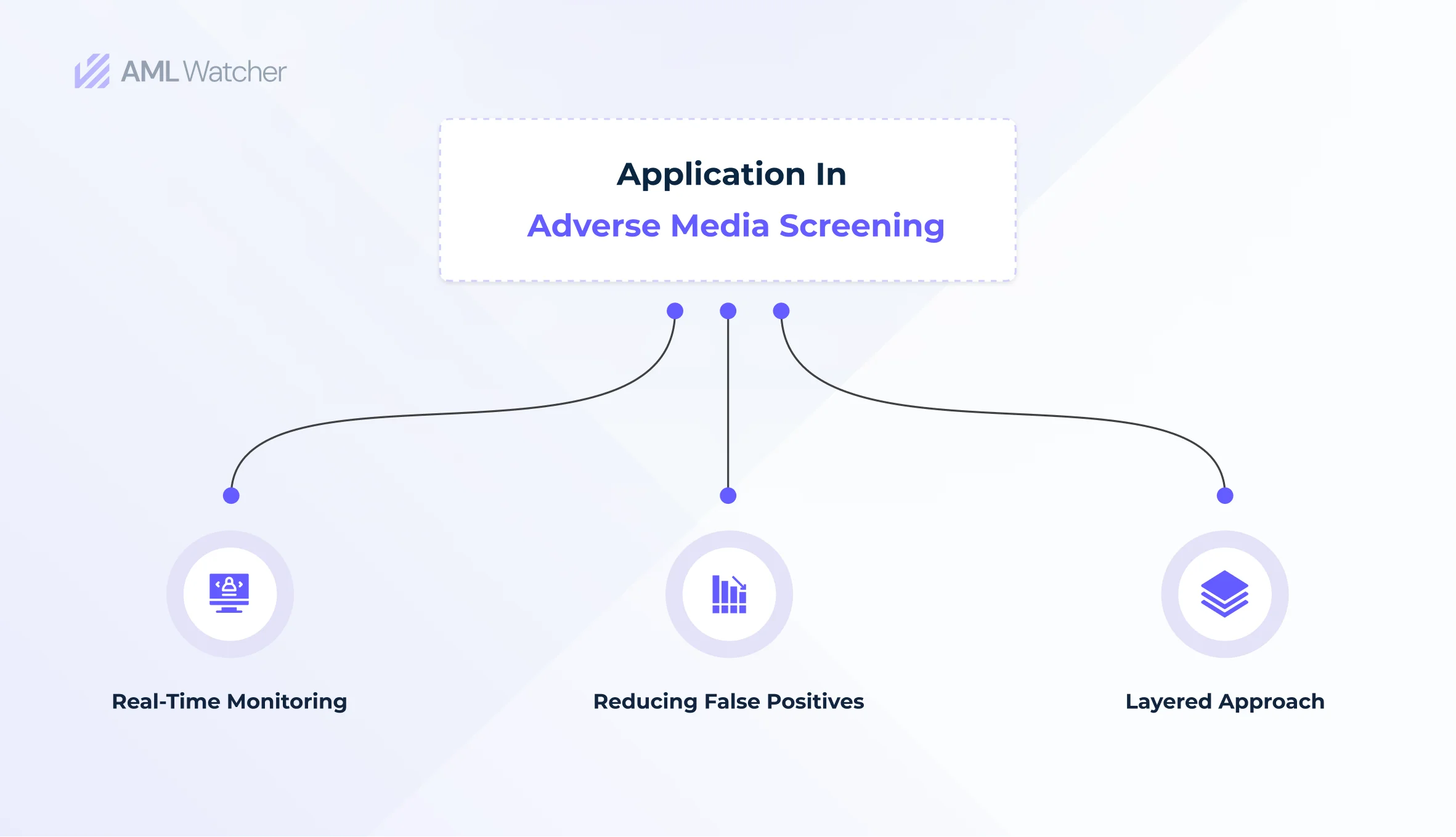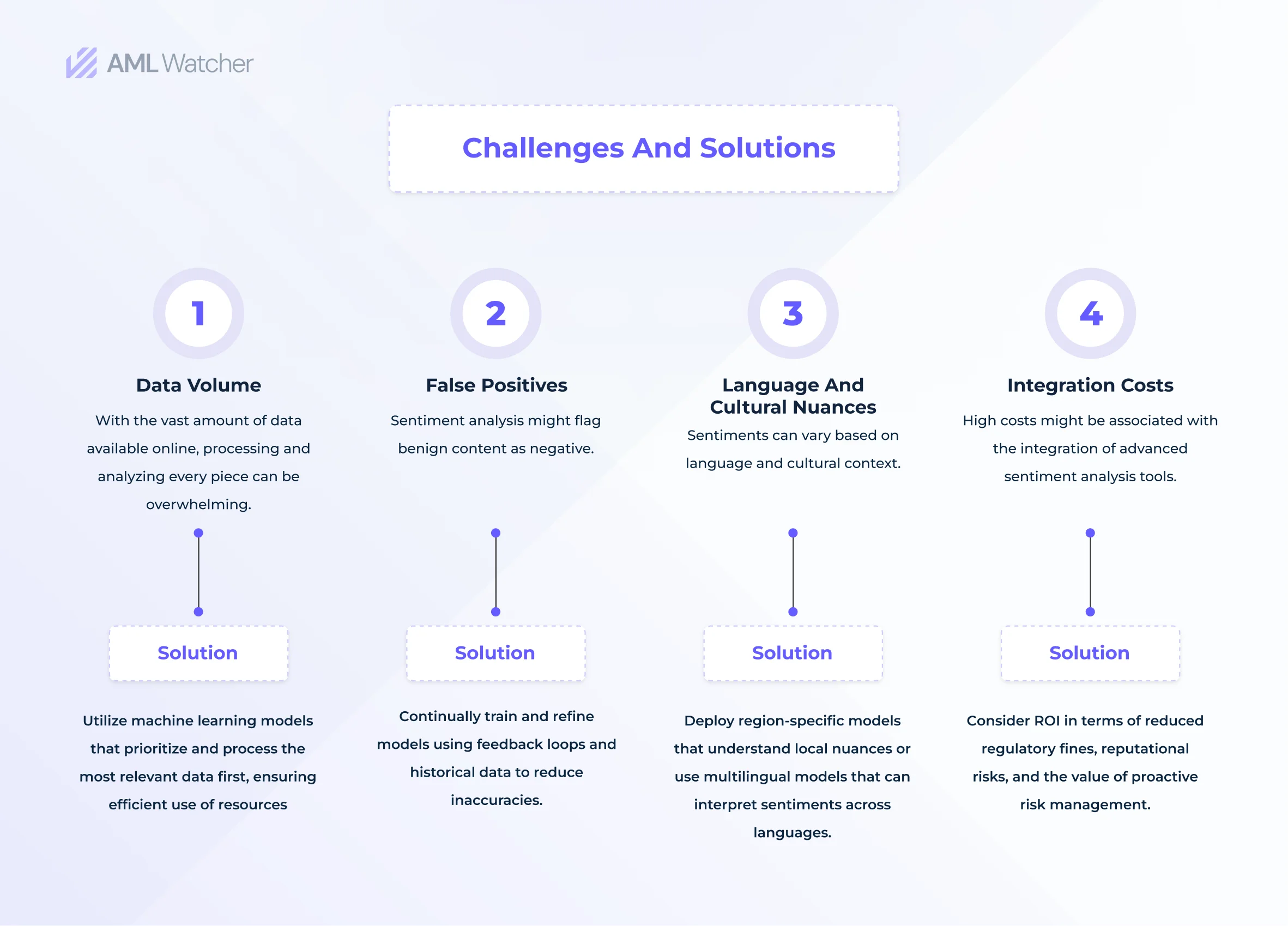
How to Make Adverse Media Your Secret Risk Detection Weapon with Sentiment

Any unfavorable news about people, organizations, or major events is referred to as Adverse Media Screening. This covers a wide range of stories, from the financial misdeeds of a corporation to the illegal deeds of an individual.
Importance in Financial Crime and Compliance
Potential Threats
Adverse media serves as a red flag, indicating possible financial crime activities like money laundering, fraud, and other illicit actions.
Reputation Risk
Banks, financial institutions, and corporations cannot afford to be associated with parties involved in scandals or crimes. Adverse media helps in identifying these parties, thus mitigating reputation risks.
Proactive Risk Management
By staying updated on adverse media, organizations can proactively assess and manage their risk exposure, ensuring regulatory compliance and averting potential financial penalties.
The Limitations of Traditional Screening
Traditional methods, including static databases, elementary keyword searches, or manual media checks, have served the compliance world for a while. However, these methods have significant limitations:
Static Nature
Static databases can quickly become outdated, failing to capture the latest developments or emerging threats.
Basic Keyword Searches
These often produce vast amounts of irrelevant results, and equally, they might miss vital information if a particular keyword isn’t used in an adverse media report.
Manual Checks
These are time-consuming, labor-intensive, and subject to human error or oversight.
Relying simply on these conventional approaches is insufficient given the dynamic nature of information sources and the constantly changing nature of risks.
Sentiment Analysis: The Game Changer
Sentiment Analysis refers to the process by which the mood or sentiment behind a text is determined. This technique categorizes the expressed opinions in the text as positive, negative, or neutral.
By Using Sentiment Analysis
- Sentiment Analysis can identify subtle negative nuances in media reports that might be overlooked by a simple keyword search. For instance, a report might not use explicit keywords like “fraud” but may convey a negative sentiment toward a company’s financial practices.
- While keyword-based searches might flag any mention of particular terms, Sentiment Analysis can distinguish between a neutral mention of a term and a genuinely negative connotation that helps in reducing false positives.
Application in Adverse Media Screening
Real-time Monitoring
Tools for sentiment analysis can continuously scan a wide range of media sources. Automated sentiment analysis delivers real-time updates as opposed to the rare and time-consuming traditional manual inspections, ensuring that organizations are immediately aware of any negative media referring to entities they are affiliated with or are contemplating a partnership. The FATF primarily tracks financial activity connected to money laundering and terrorism financing in real-time. The “grey list” is a list that FATF keeps about nations that are subject to more inspection. These nations actively work with FATF to fix strategic flaws in their AML/CFT regimes.
Reducing False Positives
One of the major issues with simple keyword checks is the volume of false positives. A company might be mentioned in a negative news context without being the primary subject of the negative sentiment. Advanced sentiment analysis algorithms can parse the context and differentiate between genuine adverse media concerning an entity and mere coincidental mentions, thereby refining the results and minimizing false alarms.
Layered Approach
Sentiment analysis should be different from traditional methods but rather enhance them. Traditional database checks offer a foundation, capturing known entities involved in financial improprieties or other illicit actions. Sentiment analysis can act as an additional layer, identifying emerging threats or nuanced negative sentiments that might be missed in traditional databases.
Case Studies
Case of HSBC and Money Laundering
According to the BBC, HSBC faced allegations in 2012 for allowing drug cartels to launder money through its bank. An advanced sentiment analysis might have flagged adverse media reports related to unusual transaction patterns or the entities involved, which could have triggered earlier investigations.
Danske Bank’s Estonian Branch Scandal
In 2018, Danske Bank came under scrutiny for around 200 billion euros of suspicious transactions that passed through its Estonian branch. Reuters reported that an effective adverse media screening might have detected early negative sentiments related to the bank’s activities in Estonia, providing a heads-up before the scandal grew to its full magnitude.
Theranos and Elizabeth Holmes
Though not directly related to financial crimes, this case serves as an example where sentiment analysis might have helped. Adverse media screening could have flagged discrepancies between the media sentiment and the company’s claims earlier on.
1MDB Scandal
The Malaysia 1MDB scandal is one of the world’s largest financial fraud cases. Earlier sentiment analysis on entities and individuals involved might have alerted institutions about the risk sooner. Reference: Comprehensive reports on the 1MDB scandal, highlighting the involvement of various financial institutions.
Consequences Due to Lack of Advanced Screening
Many organizations face regulatory fines, reputational damage, and loss of consumer trust due to their involvement in money laundering or fraudulent activities, either knowingly or unknowingly. These consequences often stem from inadequate risk detection mechanisms, including outdated or ineffective media screening practices. The cases mentioned above, especially the HSBC and Danske Bank scenarios, showcase the severe ramifications institutions face when such risks go undetected.
Integration into Modern RegTech Solutions
Incorporating Sentiment Analysis
API Integration
Many sentiment analysis tools provide Application Programming Interfaces (APIs) which allow for smooth integration into existing RegTech systems. Firms can fetch real-time sentiment data and analyze it in their current environments.
Cloud integration solution.
Many modern, regular tech tools allow for cloud-based solutions, which makes it easier for sentiment analysis to be flexible, where updates are also easier to access.
Flexible Solutions:
Businesses and organizations whose needs vary greatly from others in the market are allowed to create their custom solutions in order to redirect their focus to risk profiles alone.
Possible Challenges & Proposed Solutions
- While data volume is a consistent industry problem, utilizing AI/ML algorithms can help prioritize necessary alerts, enabling efficient use of overall business resources.
- False positives and contrasting false negatives, both are a hassle to combat. By keeping in the loop consistent feedback, the ratio of errors, and identifying patterns in detection, inaccuracies can be greatly reduced.
- Language and Cultural Differences are a big challenge, especially when it comes to matching and understanding local language models of a jurisdiction. Using highly intelligent screening software with multilingual models of variations, match accurately across a wide range of languages.
- While integration must be among the least of our worries, it must be a hassle especially when cost-effective data and screening tools are unavailable. By considering the amount of fines it imposes to ignore regulations, the benefits of risk management outweigh this one-time investment.
Conclusion
Concludingly, sentiment analysis supports layered risk assessments, improves real-time monitoring, lowers false alerts, and minimizes false alarms. Make wise judgments by staying informed and staying one step ahead! AML Watcher sees it as a fundamental shift in risk assessment and management. By gauging sentiment, businesses can identify potential threats before they escalate into major risks. This proactive approach ensures businesses and compliance teams stay ahead of regulatory requirements and make informed decisions, safeguarding their reputation and operations.
Talk to us, to learn more about sentimental analysis, Our AML Watcher professionals have an extensive amount of expertise and experience in this domain. We are here to provide guidance, respond to your questions, and provide solutions that are specific to your requirements.
We are here to consult you
Switch to AML Watcher today and reduce your current AML cost by 50% - no questions asked.
- Find right product and pricing for your business
- Get your current solution provider audit & minimise your changeover risk
- Gain expert insights with quick response time to your queries

 Compliance Guidelines: United Arab Emirates
Compliance Guidelines: United Arab Emirates
 Compliance Guidelines: Germany
Compliance Guidelines: Germany
 UK to Launch World’s First Sanctions Regime to Target Upstream People Smuggling
UK to Launch World’s First Sanctions Regime to Target Upstream People Smuggling
 Utah Lawsuit Alleges TikTok Livestreams Facilitated Money Laundering Activities
Utah Lawsuit Alleges TikTok Livestreams Facilitated Money Laundering Activities


 Why Should states conduct AML Due Diligence for CBI/RBI Investment Schemes?
Why Should states conduct AML Due Diligence for CBI/RBI Investment Schemes?
 How can businesses comply with US sanctions on vessels?
How can businesses comply with US sanctions on vessels?
 Difference In AML: DNFBPs Vs Financial Sector
Difference In AML: DNFBPs Vs Financial Sector
 Difference in EU and US Sanctions Programs - How It Impacts Compliance?
Difference in EU and US Sanctions Programs - How It Impacts Compliance?
 How Regulatory Gaps Fueling Money Laundering in High Risk Jurisdictions?
How Regulatory Gaps Fueling Money Laundering in High Risk Jurisdictions?
 Mapping Anti-Money Laundering Regulations in Malaysia
Mapping Anti-Money Laundering Regulations in Malaysia







